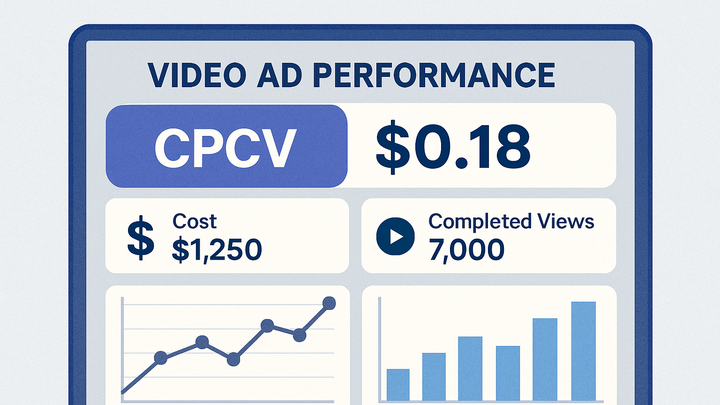Published on 2025-06-22T07:16:27Z
What is CPCV (Cost per Completed View)? Explanation and Examples
CPCV (Cost per Completed View) is a key performance metric in digital advertising analytics that measures the average cost incurred by an advertiser when a user watches a video ad to completion. It helps marketers understand the efficiency and effectiveness of their video campaigns by correlating the total ad spend to the number of full views. By focusing on completed views rather than impressions or clicks, CPCV provides a clearer picture of true audience engagement and return on investment. This metric is particularly valuable for video platforms and social media channels where full-view engagement is critical for brand awareness, product messaging, and conversion goals. Tools like PlainSignal and Google Analytics 4 enable precise tracking and optimization of CPCV, offering insights to refine targeting, creative assets, and bidding strategies for maximum impact.
Cpcv (cost per completed view)
CPCV measures average cost per full video ad view, highlighting campaign efficiency and engagement.
Understanding CPCV
This section explains the fundamental concept of CPCV and its significance in evaluating video ad campaigns.
-
Concept overview
CPCV represents the average amount an advertiser pays each time a video ad is watched from start to finish. It excludes partial views, ensuring metrics focus on full audience engagement.
-
Cost component
The total ad spend dedicated to the video campaign over a defined period, including bids, fees, and platform charges.
-
Completed views
The count of video ad plays where the viewer watched the entire ad duration without skipping.
-
-
Why cpcv matters
By tracking completed views specifically, advertisers can gauge true viewer interest and the impact of full ad exposure on brand recall and conversions.
-
Engagement quality
Full views indicate genuine engagement versus mere exposure or accidental plays.
-
Budget efficiency
Focusing spend on ads that are fully consumed helps maximize the return on ad spend.
-
Calculating CPCV
Learn the exact formula for computing CPCV and the factors that can influence the calculation.
-
Cpcv formula
Computed as total video ad cost divided by the number of completed views: CPCV = Total Cost / Completed Views.
-
Influencing factors
Campaign settings, audience targeting, ad length, and bidding strategies can all affect the unit cost and view completion rates.
-
Ad length
Longer ads may reduce completion rates, increasing CPCV if viewers drop off early.
-
Targeting precision
Highly relevant targeting typically yields better engagement and lower CPCV.
-
Tracking CPCV with Analytics Tools
Implementation examples for measuring CPCV using PlainSignal and Google Analytics 4.
-
PlainSignal setup
PlainSignal offers a cookieless, privacy-focused analytics solution that can track completed video views and associated costs.
-
Tracking code example
Embed the following script in your site’s HTML to start collecting video view data.
-
Code snippet
<link rel="preconnect" href="//eu.plainsignal.com/" crossorigin /> <script defer data-do="yourwebsitedomain.com" data-id="0GQV1xmtzQQ" data-api="//eu.plainsignal.com" src="//cdn.plainsignal.com/plainsignal-min.js"></script>
-
-
Google analytics 4 implementation
GA4 can be configured to record custom events for video completions and link ad spend data via the Google Ads integration.
-
Event tagging
Define a ‘video_complete’ event in GA4 or via Google Tag Manager and pass parameters like ad_id, campaign, and cost.
-
Ad cost import
Use the Google Ads linking feature to import cost data into GA4 for CPCV computation.
-
Optimizing CPCV
Strategies to reduce CPCV and increase the efficacy of video ad spend.
-
Creative testing
A/B test different video creatives to identify formats and messages that drive higher completion rates.
-
Message variations
Experiment with different openings and calls-to-action to hook viewers early.
-
-
Audience segmentation
Target niche audiences with tailored content to improve relevance and completion likelihood.
-
Demographic targeting
Adjust bids and creatives based on age, gender, or interests for optimal engagement.
-
-
Ad placement and frequency
Choose placements where users are more likely to watch full videos and cap view frequency to avoid ad fatigue.
-
Frequency capping
Limit the number of times an ad is shown to the same user in a given period.
-
Real-World Examples
Sample scenarios illustrating CPCV in action and how data-driven adjustments improved outcomes.
-
Consumer electronics campaign
A tech brand reduced CPCV by 25% by shortening videos and targeting high-intent audiences on social platforms.
-
E-learning promotion
An online course provider lowered CPCV by using compelling opening hooks and retargeting viewers who watched 50% of the video.
